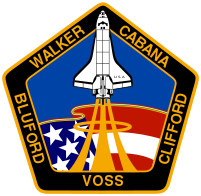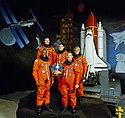STS-53
| Missionsemblem | |||||
|---|---|---|---|---|---|
 | |||||
| Missionsstatistik | |||||
| Missionsnavn: | STS-53 | ||||
| Rumagentur: | NASA | ||||
| Rumfærge: | Discovery (15) | ||||
| Antal besætningsmedlemmer: | 5 | ||||
| Affyringsrampe: | LC-39A (KSC) | ||||
| Opsendelse: | 2. december 1992 | ||||
| Landing: | 9. december 1992 | ||||
| Landet på: | Edwards Air Force Base | ||||
| Varighed: | 8 døgn og 7 timer | ||||
| Foto af besætningen | |||||
 | |||||
| Navigation | |||||
| |||||
STS-53 (Space Transportation System-53) var rumfærgen Discovery 15. rumfærge-mission. Den blev opsendt d. 2. december 1992 og vendte tilbage den 9. december 1992.
Missionen medbragte delvis klassificeret militær last for Forsvarsministeriet (USA) (DoD).
Hovedartikler:
Besætning

 David Walker (kaptajn)
David Walker (kaptajn)
 Robert Cabana (pilot)
Robert Cabana (pilot)
 Guion Bluford (1. missionsspecialist)
Guion Bluford (1. missionsspecialist)
 James Voss (2. missionsspecialist)
James Voss (2. missionsspecialist)
 Michael Clifford (3. missionsspecialist)
Michael Clifford (3. missionsspecialist)
Missionen
Missionen medbragte følgende nyttelast:
- USA 89 [1]
- Microcapsules in Space (MIS-l)
- Space Tissue Loss (STL)
- Visual Function Tester (VFT-2)
- Cosmic Radiation Effects and Activation Monitor (CREAM)
- Radiation Monitoring Equipment (RME-III)
- Fluid Acquisition and Resupply Experiment (FARE)
- Hand-held, Earth-oriented, Real-time, Cooperative, User-friendly, Location-targeting and Environmental System (HERCULES)
- Battlefield Laser Acquisition Sensor Test (BLAST)
- Cloud Logic to Optimize Use of Defense Systems (CLOUDS).
- Get Away Special (GAS)
- Orbital Debris Radar Calibration Spheres (ODERACS)
- Cryogenic Heat Pipe Experiment (GCP).
Eksterne henvisninger
- STS-42 NASA (engelsk)
- STS-53Arkiveret 21. april 2012 hos Wayback Machine NASA KSC (engelsk)
- SDS-2 Arkiveret 14. maj 2011 hos Wayback Machine Federation of American Scientists (engelsk)
- ^ USA 89 (NSSDC ID: 1992-086B) (engelsk)
| ||||||||
Medier brugt på denne side
Emblem of Nasa's STS-53 mission
- Designed by the crewmembers, the STS-53 insignia shows the Space Shuttle Discovery rising to new achievements as it trails the symbol of the Astronaut Office against a backdrop of the American flag. The five stars and three stripes also serve to symbolize the mission designation (STS-53) and America's continuing commitment to world leadership in space. The pentagonal shape of the patch represents the Department of Defense (DOD) and its support of the Space Shuttle Program. The band delineating the flag from space includes the four colors of the military services of the crewmembers. The names of the flight crewmembers are located along the border of the patch. They are Commander David M. Walker, Pilot Robert D. Cabana, Mission Specialist (MS) Guion S. Bluford, MS James S. Voss, and MS Michael R. U. Clifford. Each crewmember contributed to the design of the insignia.
STS-54 Mission Insignia
STS-52 Columbia, Orbiter Vehicle (OV) 102, crew insignia (logo), the Official insignia of the NASA STS-52 mission, features a large gold star to symbolize the crew's mission on the frontiers of space. A gold star is often used to symbolize the frontier period of the American West. The red star in the shape of the Greek letter lambda represents both the laser measurements to be taken from the Laser Geodynamic Satellite (LAGEOS II) and the Lambda Point Experiment, which is part of the United States Microgravity Payload (USMP-1). The LAGEOS II is a joint Italian \ United States (U.S.) satellite project intended to further our understanding of global plate tectonics. The USMP-1 is a microgravity facility which has French and U.S. experiments designed to test the theory of cooperative phase transitions and to study the solid\liquid interface of a metallic alloy in the low gravity environment. The remote manipulator system (RMS) arm and maple leaf are emblematic of the Canadian payload specialist Steven MacLean.
The STS-53 crew portrait included astronauts (front left to right): Guion S. Bluford, and James S. Voss, mission specialists. On the back row, left to right, are David M. Walker, commander; Robert D. Cabana, Pilot; and Michael R. (Rick) Clifford, mission specialist. The crew launched aboard the Space Shuttle Discovery on December 2, 1992 at 8:24:00 am (EST). This mission marked the final classified shuttle flight for the Department of Defense (DOD).
Forfatter/Opretter: Kwamikagami, Licens: CC BY-SA 4.0
symbol of Mars. 16 × 16 pixel nominal dimensions, lines 2 pixel thick, square caps. Colour 75% blue: red=0 green=0 blue=191 (#0000BF).
Rotated and color enhanced version of original (ISS013-E-48788 (6 July 2006) --- The Space Shuttle Discovery approaches the International Space Station for docking but before the link-up occurred, the orbiter "posed" for a thorough series of inspection photos. Leonardo Multipurpose Logistics Module can be seen in the shuttle's cargo bay. Discovery docked at the station's Pressurized Mating Adapter 2 at 9:52 a.m. CDT, July 6, 2006.)







